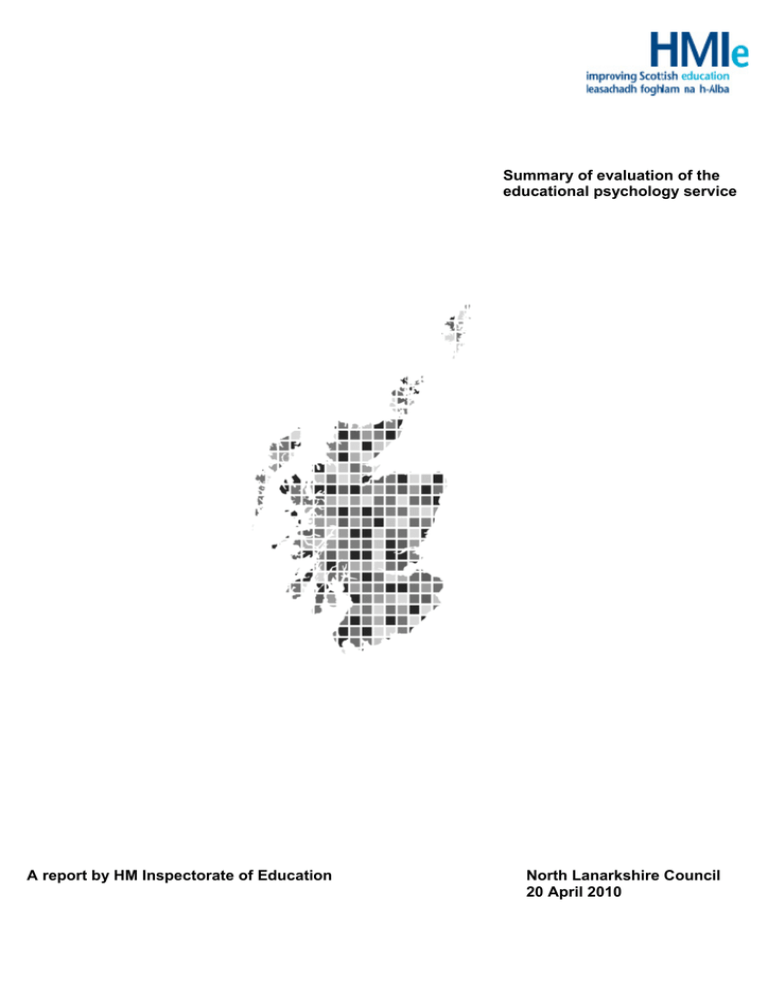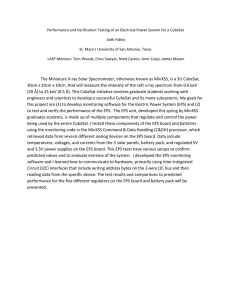Summary of evaluation of the educational psychology service
advertisement

Summary of evaluation of the educational psychology service A report by HM Inspectorate of Education North Lanarkshire Council 20 April 2010 Definition of terms used in this report. HM Inspectors use published criteria when making evaluations. They are published as quality indicators which relate evaluations to six levels. HMIE began using a six-point scale to make evaluations in August 2005. The table below shows how the six-point scale relates to the four-point scale that we used previously. Old level Very good Good New level Excellent Very good Good Fair Unsatisfactory Satisfactory Weak Unsatisfactory Description Outstanding, sector leading Major strengths Important strengths with some areas for improvement Strengths just outweigh weaknesses Important weaknesses Major weaknesses This report also uses the following words to describe numbers and proportions: almost all most majority less than half few over 90% 75-90% 50-74% 15-49% up to 15% Contents Page 1. The aims, nature and scope of the inspection 1 2. What key outcomes has the service achieved? 1 3. How well does the service meet the needs of its stakeholders? 2 4. How good is the service’s delivery of key processes? 3 5. How good is the service’s management? 4 6. How good is leadership? 4 Appendix 1 - Quality indicators 7 1. The aims, nature and scope of the inspection Recommendation 20 of the Review of Provision of Educational Psychology Services in Scotland (2002) charged HM Inspectorate of Education (HMIE), on behalf of the Scottish Ministers, to provide an external evaluation of the effectiveness of the Educational Psychology Service (EPS) in improving the impact and outcomes for children, young people and families. The inspection of North Lanarkshire Council educational psychology provision was undertaken on behalf of stakeholders. The evaluation of EPS was conducted within a framework of quality indicators which embody the Government’s policy on Best Value. The inspection team also included an Associate Assessor who was a principal educational psychologist (PEP) serving in another Scottish local authority. This web-based report should be read alongside other strategic inspections of North Lanarkshire Council which sets out the wider context in which EPS are delivered. The Educational Psychology Service The North Lanarkshire EPS was based across three centres in Cumbernauld, Motherwell and Monklands. At the time of the inspection, the complement of educational psychologists (EPs) was 29.1 full-time equivalents (FTE). There was one 0.5 FT educational psychologist post unfilled at the time of inspection. There were two research and development officers and one seconded teacher. Promoted staff consisted of two depute principal educational psychologists (DPEP), who were jointly acting as the interim PEP, eight senior educational psychologists (SEPs) and one acting senior educational psychologist (SEP). There were 8.0 FTE administrative support staff. Each office was supported by a senior administrative worker. A new PEP had been appointed and was due to take up post in February 2010. 2. What key outcomes has the service achieved? Overall, the EPS had made a good contribution to improvements in performance. A number of EPs had worked well in partnership with centrally deployed staff to develop policy and practice across the authority. There was effective joint working at a range of levels. This included strategic developments with a number of education support services, for example, the North Lanarkshire’s Active Literacy Strategy and the contribution of the service to the development of the Corporate Parenting Strategy. The EPS had undertaken effective research to support developments in relation to loss and trauma, self-harm protocols and the evaluation of the Campus Cops initiative. EPs across the service contributed to a large number of working groups, steering groups and advisory groups within the authority. For example, EPs had made effective contributions to Curriculum for Excellence and the development of locality groups. The service should now review the range and nature of its commitment to meetings and working groups to ensure that there is an appropriate outcome focus in every case. The EPS had made some very positive steps in collecting evidence from stakeholder evaluations and focus groups to demonstrate improvements in service delivery including their helpful customer care policy. The service had not yet made effective use of 1 performance measures to demonstrate trends over time. Performance measures were not yet embedded in planning to allow evaluation of performance against national, local and EPS aims and objectives. EPs across the service demonstrated good knowledge and understanding of relevant statutory requirements. The service systematically complied with appropriate guidance and legislation. There was a well-developed understanding of child protection issues across the service. The service was aware that further work was required regarding their wider statutory duties in collaboration with the Children’s Reporter. Features of good practice The Gateway project is a partnership between the Home Office and the United Nations High Commission for Refugees. Its aim is to resettle in the UK up to 500 refugees per year. It provides a safe route to the UK for survivors of severe trauma from all parts of the world. The project is a very good example of partnership working and the EPS have made significant and highly skilled contributions to improving the lives chances of children and their families with refugee status. The Active Literacy Strategy, is a longitudinal research programme, which focused on improving the literacy skills of children and young people through extensive training of staff, and the development of supportive teaching resources. 3. How well does the service meet the needs of its stakeholders? The service had developed very good working relationships with children, young people and families across North Lanarkshire. Children and young people were very positive about the service they received from the EPS. The EPS had been involved in a range of initiatives to meet more effectively the needs of children and young people. For example, the involvement of children and young people in the development of a programme to provide support for family change, including divorce and separation. The EPS had also been involved with a range of partners in the development of The Gateway Project developed to provide support for vulnerable refugees. The service was building on these positive initiatives by developing creative ways of involving and consulting with the most vulnerable children and young people at an early stage of EPS involvement. Nearly all parents felt that EPs were supportive and responsive and took care to ensure that they were involved in making decisions about plans to support their child. A few parents stated that the interventions made by EPs had made a significant impact on their ability to cope with difficult circumstances. Parents particularly valued the support from the EPS at times of important educational transitions. Parents would welcome more readily available information about the service. A number of families felt that the quality of service across the authority was variable. 2 Schools were well supported by the EPS. There were a number of examples of the EPS supporting schools, through a range of key developments, to achieve better outcomes for children and young people. This included sensitive and effective casework. For example, the service had made positive contributions to improving outcomes for a range of children and young people including those in the early years, those with dyslexic difficulties and those who were looked after and accommodated by the authority 1 . Schools valued the support of their link EP at the joint assessment team meetings. Most schools felt that the EPS respected the confidentiality of children and young people, parents and staff. The service had much improved its communication and joint working with centrally deployed staff. For example, the EPS had been commissioned to explore parental experiences of transitions post school for young people with severe and complex learning difficulties. Greater clarity regarding the roles, remits and expectations of the EPS was required by schools and centrally deployed staff to enable them to meet the needs of all children and young people. Staff across the service were highly motivated. They were able to participate in a wide range of professional development opportunities, which allowed them to improve the quality of their service delivery. Support for EPs in their probationary year was highly regarded. A number of staff would welcome a more formal support and supervision structure developed to meet the needs of all staff. The DPEPS had worked hard, with the support of the service, to develop one whole service team. Nearly all staff were involved in regular annual performance reviews linked directly to professional development outcomes. The service was represented on a growing number of national groups and had presented at national conferences. The EPS had been involved in an innovative benchmarking group with a number of local EPS exploring service performance. Some of the work delivered by the service had influenced wider developments within the authority, such as the solution orientated schools initiative and their work to support the needs of young people requiring more choices and more chances. The service should disseminate more of this innovative practice beyond the authority. 4. How good is the service’s delivery of key processes? The EPS delivered a broad and balanced range of services across consultation and advice, assessment, intervention, training and research. The service provided good consultation and advice in relation to individual children and young people. The service had in place a range of appropriate assessment tools and assessment was effectively linked to authority staged intervention procedures. The EPS recognised the need to further improve assessment and develop a whole service strategy. The service supported and delivered a wide range of very good and carefully planned interventions to address individual, school and family priorities. This included Seasons for Growth and video interaction guidance to support positive communication with vulnerable 1 Looked after and accommodated children (LAAC) 3 children at the early years. EPs in nearly all cases ensured that interventions involved parents, schools and others as appropriate. The EPS had a helpful portfolio of training and development activities, including training on active learning, resilience planning and the motivated school. Staff undertook good research and strategic development activity to meet service and a number of authority priorities in improving outcomes for children and young people. Research and strategic development was well supported by the two research and development officers. Research projects and findings had been published in peer-reviewed journals. Further work is required to ensure that schools, centrally deployed staff and partner agencies are aware of the wide range of services delivered by EPS, specifically their role in training and research. Feature of good practice: Interventions to support families through change The service has researched and developed an innovative and sensitive programme to support the needs of children and young people through times of family change. 5. How good is the service’s management? The service recognised that further development was required to link its work more effectively to the key priorities of the Learning and Leisure Services and the Council. Efforts should be made for greater transparency in the planning process to demonstrate how improvements in performance impact on local and national priorities. Clearer targets in planning were required to evaluate service delivery against identified objectives and support the measurement of trends over time. The policy framework required to be reviewed to better reflect service priorities, and monitored in terms of implementation and effectiveness. There were a number of good examples of the service consulting with stakeholders including their work with young people and parents in relation to dyslexia. There was not as yet, a well-planned and systematic programme in place to enable active participation of stakeholders in the work of the service. The EPS plans to consult more formally with stakeholder reference groups in the future around service developments, policy issues and initiatives. The service had developed some effective partnerships with a range of stakeholders including their work supporting young offenders, and improved communication with the Speech and Language Therapy Service. However, there was still a need to define more clearly the roles and responsibilities of key partners with those of the EPs to ensure best value. 6. How good is leadership? Senior Service Managers know the EPS well and value the contribution of the service to improving outcomes for children and families. Senior Service Managers, the DPEPs and service staff showed a strong commitment to continuous improvement. They had 4 recognised the need for stronger shared direction, improved strategic communication and more effective planning to ensure accountability and continuous improvement in the work of the EPS. Senior managers at authority and service levels encouraged innovation and creativity and provided a range of opportunities for distributive leadership. Staff across the service demonstrated leadership in relation to their specific remits including through their role in multi-agency groups and in aspects of research. The two DPEPs had a strong impact on the service at operational levels. For example, they had created a supportive service ethos and provided direction to team members. They also worked well together to influence the future direction of the service. They had ably supported the service in their role as interim PEP. SEPs provided effective leadership in their areas of responsibility. The service had a history of self-evaluation and had involved the whole service in developing an improvement agenda. However, management information to evaluate service impact and outcomes over time was not used efficiently or effectively embedded within normal service activity. The EPS had shown that it had the capacity to continue to improve. The new management team of a PEP and two DPEPs is well-placed to bring about positive change. Senior education officers in partnership with the EPS, should ensure that the service continues to add value to the priorities of the Council. Key strengths The service had: • established innovative practices which were making a positive difference to children, young people and their families; • demonstrated a high commitment to improvement through its openness and reflective practice; • with the support of the DPEPs, established a stronger staff team and created a more positive staff ethos, and • promoted effective leadership at all levels. 5 Main points for action The service, with the support of the authority should: • develop a more robust and systematic management information system to improve planning and evaluate the impact of its services at all levels, • develop a more coherent policy framework to ensure consistency of practice , and • strengthen strategic links and improve working relationships with a range of partners. As a result of the EPS effective performance and good understanding of their strengths and areas for improvement we have ended the inspection process at this stage. Anna Boni HM Inspector Directorate 5 20 April 2010 6 Appendix 1 Quality Indicator Evaluation Improvements in performance Fulfilment of statutory duties Impact on children and young people Impact on parents, carers and families Impact on staff Impact on the local community Impact on the wider community Consultation and advice Assessment Intervention Provision of professional development and training for other groups including parents, teachers and health professionals Research and strategic development Inclusion, equality and fairness Policy development and review Participation of stakeholders Operational planning Partnership working Leadership and direction Leadership of change and improvement 7 good good very good very good good good good good good very good good good good satisfactory good satisfactory satisfactory satisfactory good If you would like to find out more about our inspections or get an electronic copy of this report, please go to www.hmie.gov.uk. Please contact us if you want to know how to get the report in a different format, for example, in a translation, or if you wish to comment about any aspect of our inspections. You can contact us at HMIEenquiries@hmie.gsi.gov.uk or write to us at BMCT, HM Inspectorate of Education, Denholm House, Almondvale Business Park, Almondvale Way, Livingston EH54 6GA. Text phone users can contact us on 01506 600 236. This is a service for deaf users. Please do not use this number for voice calls as the line will not connect you to a member of staff. You can find our complaints procedure on our website www.hmie.gov.uk or alternatively you can contact our Complaints Manager, at the address above or by telephoning 01506 600259. Crown Copyright 2010 HM Inspectorate of Education




